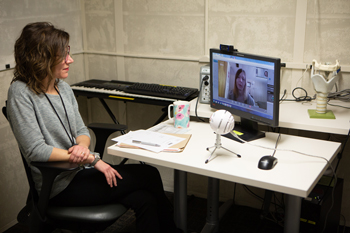Telemedicine… what the heck is it and how do I get started?

By Emily Dawson

Clinicians in the Total Parenteral Nutrition clinic use telemedicine to connect with patients in remote locations. (Photo by Yuri Markarov)
Many of our clinicians and educators are familiar with the term “telemedicine” and may have used this platform in some form over the years. With the rapid advances in technology, there are expanded opportunities for staff and physicians to use telemedicine and create exceptional patient care and learning experiences.
The Telemedicine Program at St. Michael’s was created in 2004, beginning with the delivery of education to remote sites and expanded to include clinical consultations the following year. Today, our clinicians see thousands of patients remotely each year, bringing care closer to home and improving access across Ontario and beyond.
We caught up with Carol Flewelling to learn more.
The provincial government is emphasizing “virtual care” in its new plans – is this what telemedicine is all about?
Yes and no! Virtual care is a broad term that includes telemedicine as well as other ways of seeing and caring for patients.
At St. Michael’s – and across Unity Health Toronto – telemedicine refers primarily to a secure videoconferencing platform that links patients and their health-care providers, allowing them to see each other at a distance.
Can you talk about some of the most impactful benefits of using telemedicine?
It really comes down to access to care and efficiencies. Telemedicine provides access to specialists and emergency care for people who may not have that in their community, or who are unable to access the care for other reasons. It also helps expand the circle of care as family members and local clinical supports can be included as needed.
Telemedicine helps reduce the risks, costs and travel time for patients, families and health-care providers.

Speech language pathologist Gwen Merrick uses telepractice to treat patients who can’t physically attend sessions in the Voice Clinic at St. Michael’s. (Photo by Katie Cooper)
It’s important to note that telemedicine also supports people right here in the GTA. There are people in the city who have difficulty accessing clinical appointments for reasons other than geography.
As a priority program within the education portfolio, we run many programs that link practitioners from around the world to share best practices, new discoveries and research. We also have great examples of providing patient and family education remotely. As well, we frequently run webinars and education programs with people and organizations around the city, such as members of the Toronto Academic Health Science Network.
What do patients say about telemedicine? Is it actually improving their care?
We continually ask patients to share feedback and we collect data on what’s working and where we can improve.
The common themes in their feedback are the positive impact on their resources, such as time and money, and access to specialists not otherwise available to them.
How do I know if telemedicine is feasible or appropriate for my discipline/program?
Contact our team at telemedicine@smh.ca. We will meet with you to understand how you are currently delivering care. With that as a starting point, we’ll provide you with examples of how other programs are using telemedicine, and help you design a service.
How does your team support telemedicine “newbies” to get started with this technology?
We always recommend that “newbies” access our program to schedule and organize their telemedicine clinics. We can help you follow best practices that we know result in a better experience for patients and providers. Once the clinical service is running smoothly, we begin discussions on integrating telemedicine into routine practices. We also offer training and resource guides and we’re always available for support!
About St. Michael’s Hospital
St. Michael’s Hospital provides compassionate care to all who enter its doors. The hospital also provides outstanding medical education to future health care professionals in more than 29 academic disciplines. Critical care and trauma, heart disease, neurosurgery, diabetes, cancer care, care of the homeless and global health are among the Hospital’s recognized areas of expertise. Through the Keenan Research Centre and the Li Ka Shing International Healthcare Education Centre, which make up the Li Ka Shing Knowledge Institute, research and education at St. Michael’s Hospital are recognized and make an impact around the world. Founded in 1892, the hospital is fully affiliated with the University of Toronto.
About Unity Health Toronto
Unity Health Toronto, comprised of Providence Healthcare, St. Joseph’s Health Centre and St. Michael’s Hospital, works to advance the health of everyone in our urban communities and beyond. Our health network serves patients, residents and clients across the full spectrum of care, spanning primary care, secondary community care, tertiary and quaternary care services to post-acute through rehabilitation, palliative care and long-term care, while investing in world-class research and education. For more information, visit www.unityhealth.to.
